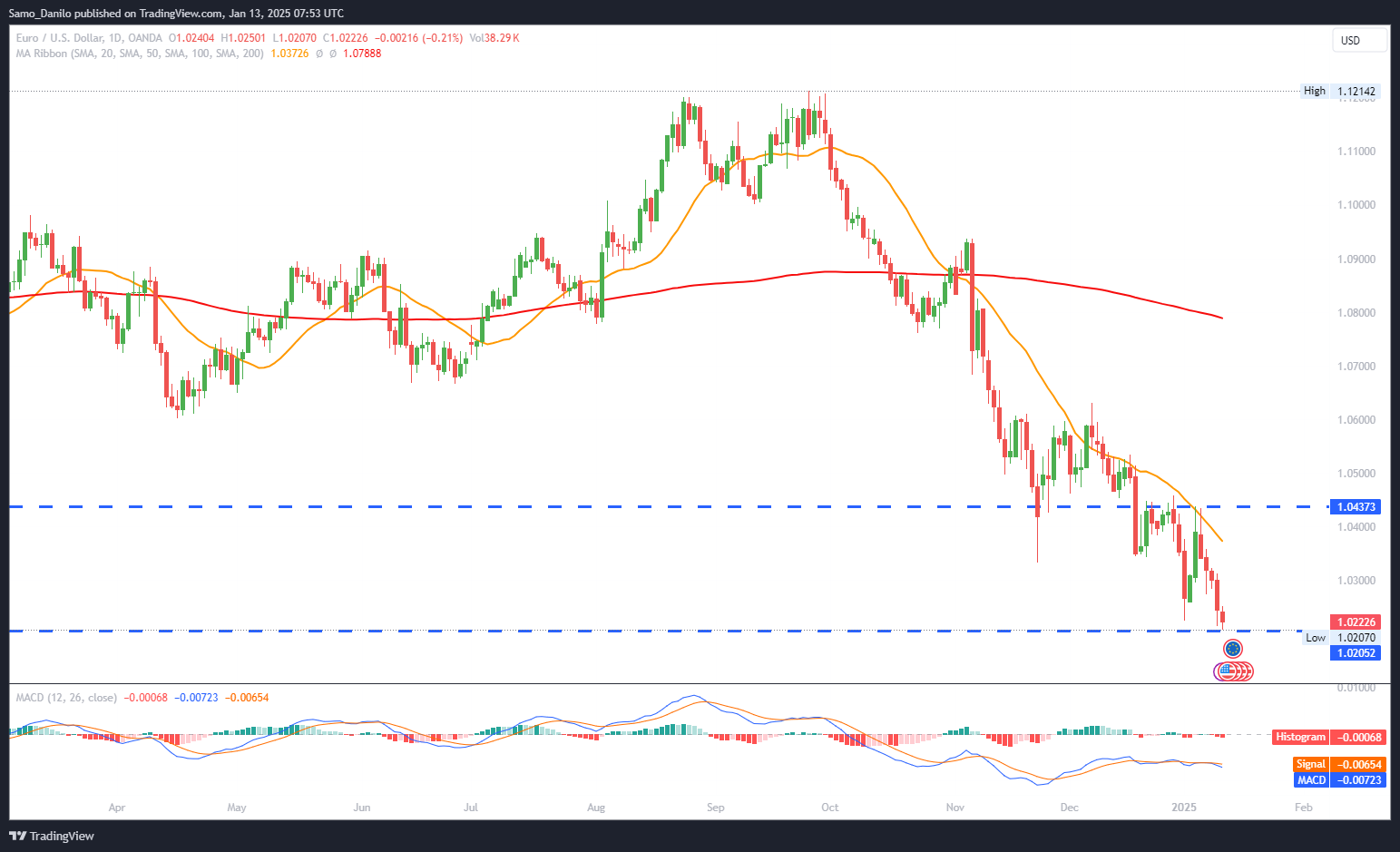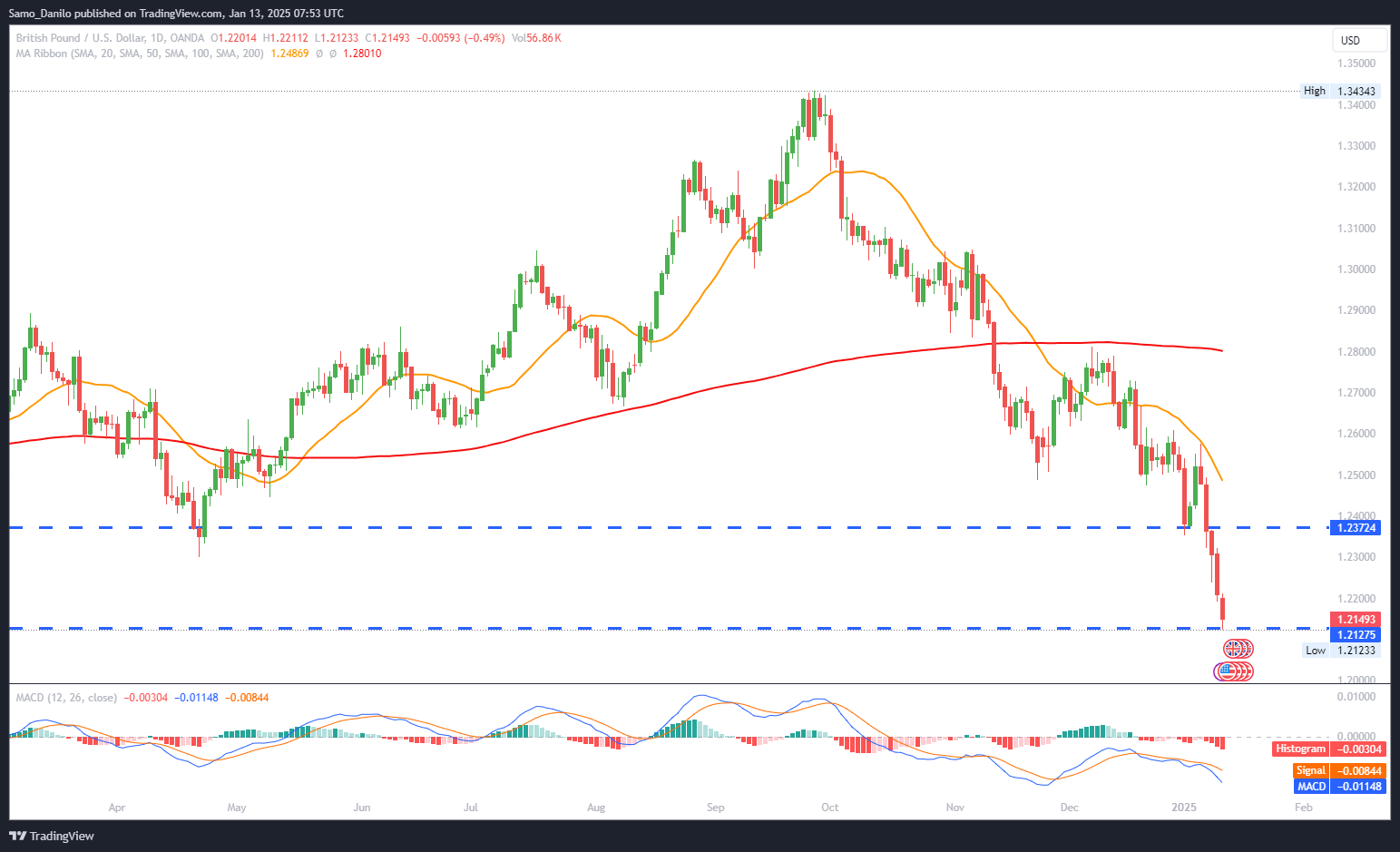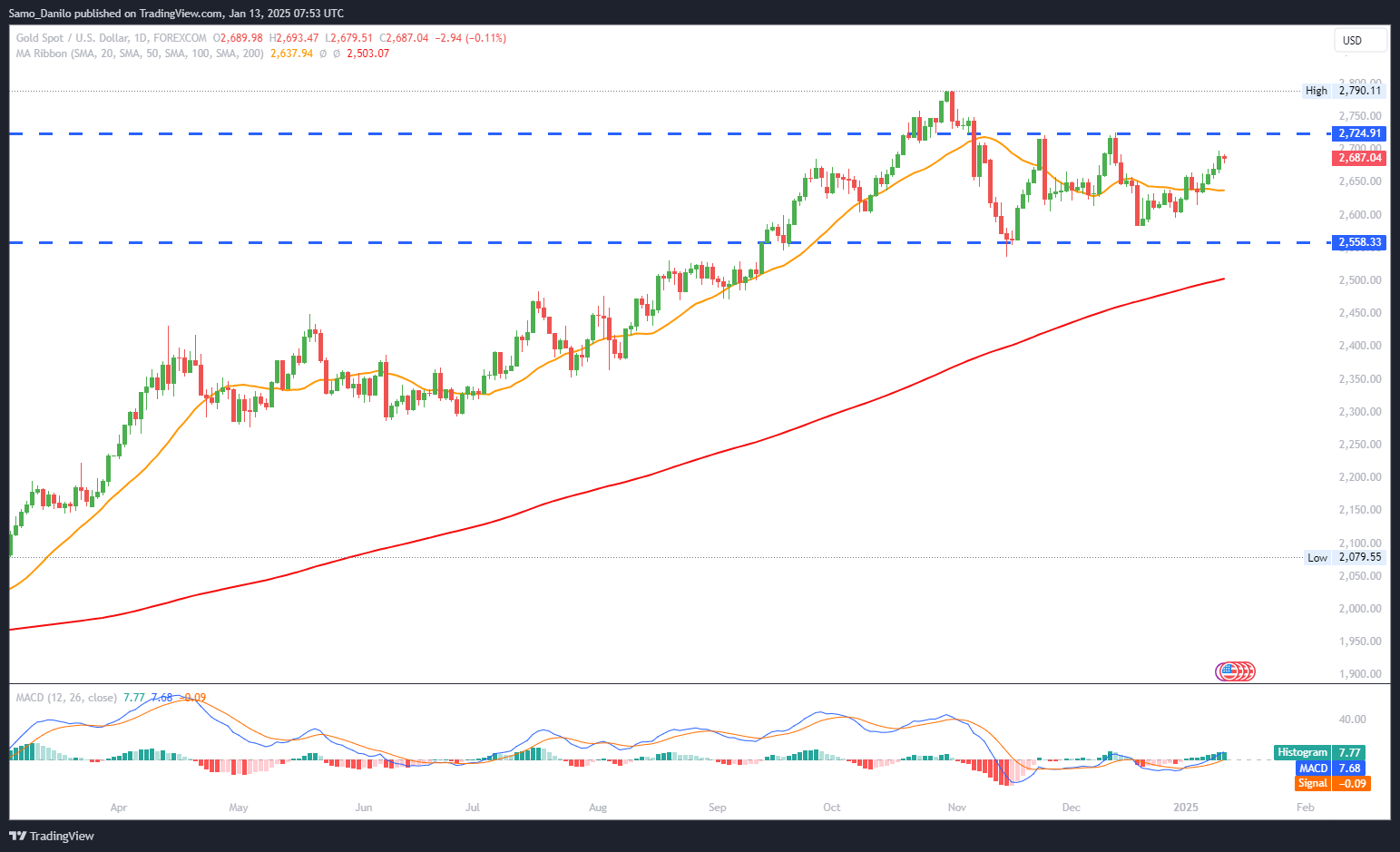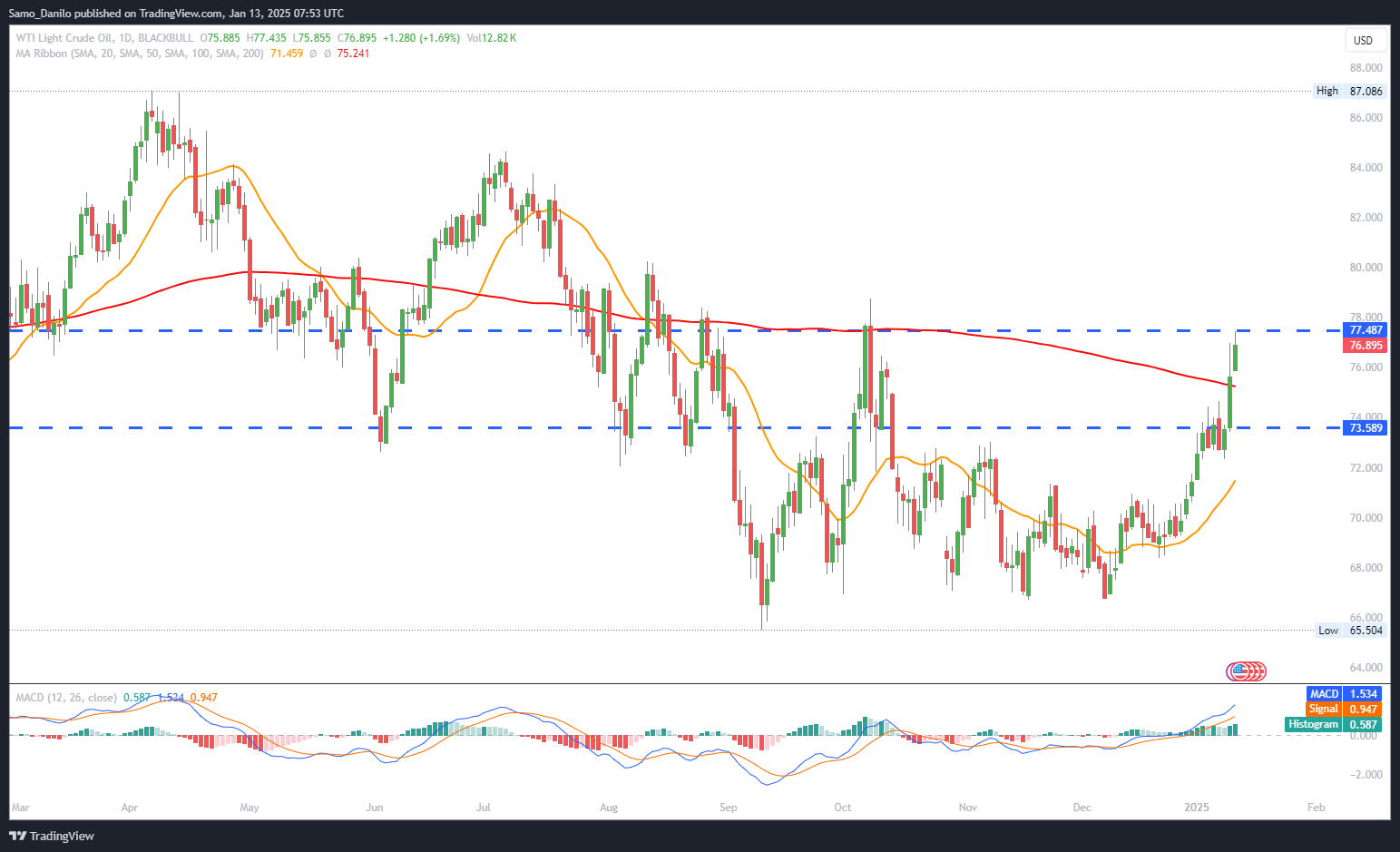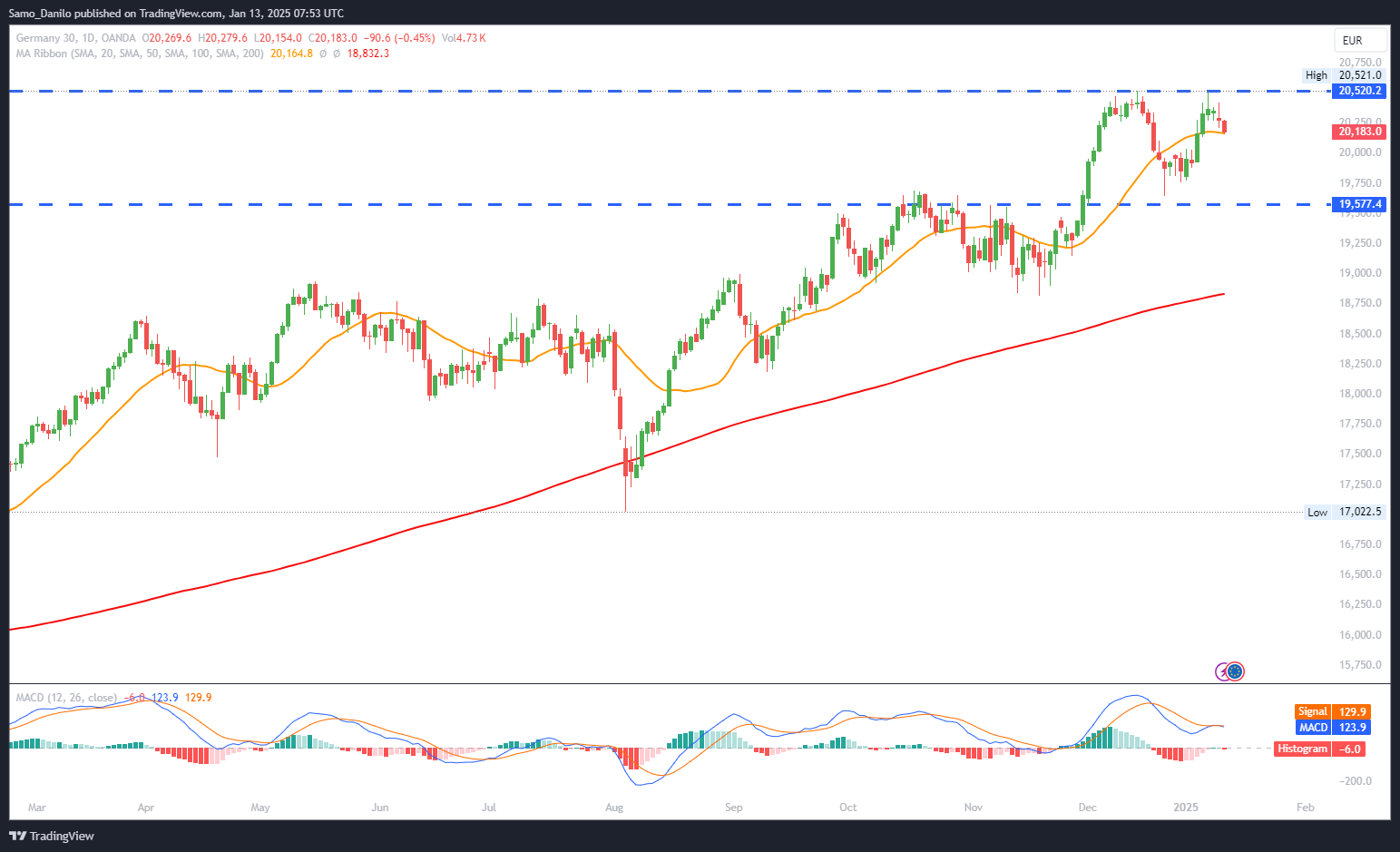EURUSD
- EUR/USD Price: The EUR/USD pair remains under pressure, trading around 1.0215 during Monday’s early European session. Persistent US Dollar strength, coupled with soft Eurozone sentiment, continues to weigh on the pair.
- ECB Hawkish Stance: ECB policymaker François Villeroy indicated that interest rate hikes would continue at a steady pace toward the neutral rate by summer, even as inflation pressures are expected to rise modestly in December.
- ECB Concerns: ECB policymaker Olli Rehn expressed concerns about the potential impact of a trade war on the Eurozone, emphasizing that Europe should not bear the brunt of tariff disputes. This highlights the geopolitical risks facing the shared currency.
- ECB Chief Economist: ECB Chief Economist Phillip Lane hinted at more easing ahead, stating that for inflation to sustainably reach the 2% target, a significant decline in services inflation from the current 4% level is necessary. Lane underlined the importance of balancing aggressive and cautious policy moves in 2024.
- US Dollar Strength: The US Dollar gained traction following strong December employment data, which reinforces expectations that the US Federal Reserve will maintain its current interest rate stance at the January meeting.
Closing statement: EUR/USD remains vulnerable to downside risks amid hawkish ECB rhetoric, geopolitical trade uncertainties, and the strength of the US Dollar. Upcoming Eurozone inflation data and US economic releases will likely dictate the pair's near-term trajectory.
GBPUSD
- GBP/USD Price: The GBP/USD pair remains under pressure, trading near 1.2200, its lowest level since November 2023. Monday’s Asian session saw the pair enter a consolidation phase after Friday’s sharp decline, suggesting some market caution.
- Technical Indicators: A slightly oversold Relative Strength Index (RSI) on the daily chart indicates the likelihood of a short-term bounce or consolidation before a further downward move. Traders are advised to await clearer directional signals.
- UK Stagflation: The British Pound struggles amid heightened concerns of stagflation, driven by persistently high inflation and slowing economic growth in the UK. This macroeconomic backdrop continues to dampen GBP’s appeal.
- Labor Market Data: The Greenback gains momentum following stronger-than-expected US job growth in December, with the unemployment rate dropping to 4.1%. The robust data supports the case for the Fed pausing rate cuts and potentially hiking rates later in the year.
- Fed Rate Expectations: Market sentiment reflects growing confidence that the Federal Reserve will halt its rate-cutting cycle at this month’s meeting. Speculation of a rate hike later in 2024 further strengthens the US Dollar, amplifying downside risks for GBP/USD.
Closing statement: GBP/USD remains vulnerable amid UK stagflation fears and a strong US Dollar driven by robust employment data and shifting Fed expectations. Near-term focus will be on UK inflation figures and Fed commentary, which could set the tone for the pair’s next move.
XAUUSD
- Gold Price: Gold price begins the week with a softer tone, retreating from the one-month high reached on Friday. This pullback reflects some profit-taking as traders assess the next catalyst for price movement.
- China’s Economic Measures: Efforts by China to stabilize the Yuan and boost economic growth have provided underlying support for gold. This reinforces its status as a safe-haven asset, mitigating downside risks despite recent weakness.
- Global Demand: Reuters reports that Indian gold demand softened as local prices hit monthly highs, leading to higher discounts. However, demand in China, the world’s largest gold consumer, has shown signs of revival as the Year of the Snake approaches.
- US Labor Market: The US Nonfarm Payrolls (NFP) report revealed a December job gain of 256K, surpassing expectations. The unemployment rate fell to 4.1%, reinforcing expectations of a hawkish Federal Reserve, which weighed on gold as rising yields reduce its appeal.
- US CPI Data: Traders now turn their attention to the US Consumer Price Index (CPI) report due Wednesday, a key metric for gauging inflation trends and the Federal Reserve's monetary policy outlook. Gold's ability to sustain gains will depend on this critical data release.
Closing statement: XAU/USD faces headwinds from a strong US labor market and hawkish Fed expectations but is supported by Chinese economic measures and safe-haven demand. The upcoming US CPI data will likely dictate the next significant move in gold prices.
CRUDE OIL
- WTI Price: West Texas Intermediate (WTI) oil prices continue their upward trajectory, trading near $77.80 per barrel, levels last seen in early October. This marks the third consecutive session of gains as bullish momentum persists.
- Broader US Sanctions: The US Treasury expanded sanctions on Russian oil producers, including Gazprom Neft and Surgutneftegas, and 183 vessels involved in Russian oil transport. These measures are expected to tighten global supply, offering further support to crude prices.
- US Labor Market: Friday's stronger-than-expected US jobs report highlighted economic resilience, improving the outlook for oil demand. A healthier labor market typically correlates with increased industrial and transportation fuel consumption.
- Seasonal Factors: Crude prices benefit from heightened winter energy demand, declining US inventories, and speculation about potential policy shifts under President-elect Donald Trump. Additionally, colder weather in the Northern Hemisphere is driving higher heating oil consumption.
- Asian LNG Premium: Spot Asian LNG prices are trading at a premium to oil, increasing the likelihood of substitution toward crude oil products for energy needs. This dynamic adds further upward pressure on WTI prices.
Closing statement: WTI crude oil prices remain buoyed by tightening supply due to geopolitical developments, seasonal demand, and strong economic indicators. Traders will closely monitor further policy announcements and inventory data for additional price drivers.
DAX
- DAX Price: The DAX fell by 0.50% on Friday, closing at 20,215 and marking its third consecutive losing session. Thursday’s minor 0.06% drop set the stage for a continuation of bearish momentum, though the index remains above key technical levels.
- Technical Signals: Despite recent losses, the DAX holds comfortably above its 50-day and 200-day Exponential Moving Averages (EMAs), suggesting that the broader trend remains bullish. Traders may look for these levels to act as support in the near term.
- China and US Tariffs: Concerns over weaker demand for German goods in China and ongoing US tariff threats remain key downside risks. These factors weigh on investor sentiment, creating uncertainty about the DAX's short-term performance.
- US Labor Market: US labor market data released on January 10 exceeded expectations, with nonfarm payrolls rising by 256K in December. The data suggests continued resilience in the US economy, supporting the narrative of a higher-for-longer Fed rate path, which could indirectly impact European equity markets.
- Inflation Data: Traders are eyeing Monday's release of US consumer inflation expectations, forecast to rise to 3.1% in December from 3.0% in November. The data will precede Wednesday's critical US CPI report, which could shape global market dynamics and influence the DAX.
Closing statement: The DAX faces near-term uncertainty driven by external economic challenges and US monetary policy expectations. However, its position above major technical support levels offers some optimism for a potential rebound, pending clarity on inflation trends and tariff developments.
